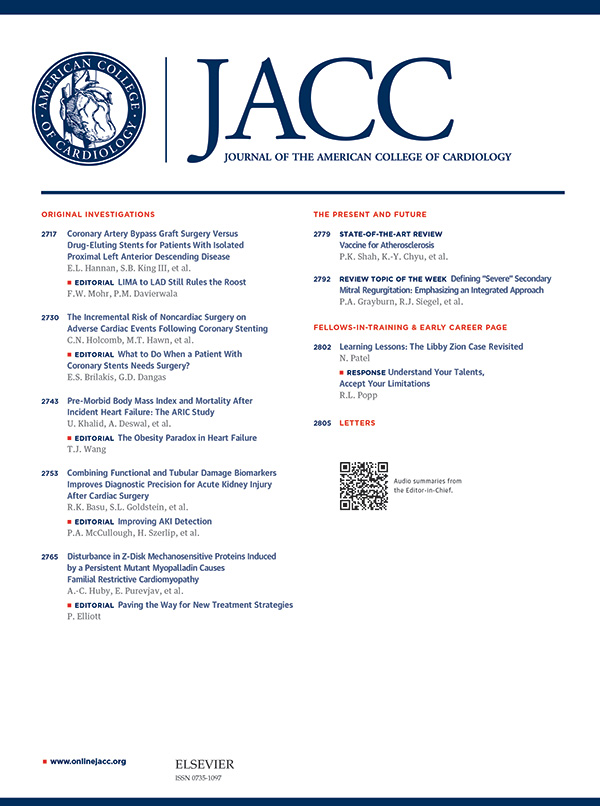雷西替单抗作为他汀类药物的附加疗法治疗非家族性高胆固醇血症:随机 3 期 REMAIN-2 试验
IF 21.7
1区 医学
Q1 CARDIAC & CARDIOVASCULAR SYSTEMS
引用次数: 0
摘要
背景目前可用的抗丙蛋白转化酶枯草酶/kexin 9 型单克隆抗体可有效降低低密度脂蛋白胆固醇(LDL-C)水平,但需要频繁给药。Recaticimab 是一种新型人源化单克隆抗体,可抗 9 型丙蛋白转化酶枯草酶/kexin。在一项 1b/2 期试验中,雷西替单抗作为稳定他汀类药物的附加疗法,在高胆固醇血症患者中显示出强劲的 LDL-C 降幅,给药间隔可达每 12 周一次(Q12W)。REMAIN-2(RecaticiMab Add-on therapy In patients with Nonfamilial hypercholesterolemia)旨在评估雷西替单抗作为他汀类药物附加疗法对非家族性高胆固醇血症患者进行 48 周治疗的有效性和安全性。在试运行期间,患者服用稳定的中度或高强度他汀类药物,同时服用或不服用胆固醇吸收抑制剂(依折麦布)或非诺贝特,疗程≥4周。低密度脂蛋白胆固醇含量≥1.8毫摩尔/升(如果患有动脉粥样硬化性心血管疾病[ASCVD])或≥2.6毫摩尔/升(如果没有ASCVD)的患者将随机(2:2:2:1:1:1)接受雷西替单抗150毫克每4周一次(Q4W)、300毫克每8周一次(Q8W)或450毫克Q12W,或匹配的安慰剂注射(Q4W、Q8W或Q12W),共48周。主要疗效终点是低密度脂蛋白胆固醇水平从基线到第24周的百分比变化。结果共有689名随机分配的患者接受了治疗(平均年龄55.8岁;男性,64.4%;有ASCVD病史,69.5%;同时服用依折麦布,11.2%;平均基线低密度脂蛋白胆固醇为2.8毫摩尔/升)。从基线到第24周,recaticimab与安慰剂相比,LDL-C的百分比变化更明显(P <0.0001),150 mg Q4W、300 mg Q8W和450 mg Q12W方案的最小二乘平均差分别为-62.2%(95% CI:-67.0%至-57.4%)、-59.7%(95% CI:-65.0%至-54.4%)和-53.4%(95% CI:-58.7%至-48.2%)。使用雷西替单抗后,低密度脂蛋白胆固醇的降幅一直保持到第48周。非高密度脂蛋白胆固醇、载脂蛋白B和脂蛋白(a)等次要血脂变量也有利于雷西替单抗组。在治疗期间,雷西替单抗组和安慰剂组的治疗相关不良事件发生率(28.5% vs 26.6%)和严重治疗相关不良事件发生率(0.4% vs 0.4%)同样很低。结论雷西替单抗作为稳定他汀类药物治疗的附加疗法,能在第24周显著降低LDL-C水平,并在第48周保持下降趋势,为非家族性高胆固醇血症患者提供了一种新的治疗选择,用药间隔可达每12周一次。本文章由计算机程序翻译,如有差异,请以英文原文为准。
Recaticimab as Add-On Therapy to Statins for Nonfamilial Hypercholesterolemia
Background
Currently available antiproprotein convertase subtilisin/kexin type 9 monoclonal antibodies can effectively decrease low-density lipoprotein cholesterol (LDL-C) levels, but require frequent dosing. Recaticimab is a novel humanized monoclonal antibody against proprotein convertase subtilisin/kexin type 9. In a phase 1b/2 trial, recaticimab as add-on to stable statins showed robust LDL-C reduction with a dosing interval up to every 12 weeks (Q12W) in patients with hypercholesterolemia.
Objectives
REMAIN-2 (REcaticiMab Add-on therapy In patients with Nonfamilial hypercholesterolemia) aimed to assess the efficacy and safety of 48-week treatment with recaticimab as add-on therapy to statins in nonfamilial hypercholesterolemia.
Methods
REMAIN-2 was a multicenter, randomized, double-blind, placebo-controlled, phase 3 trial. During the run-in period, patients received stable moderate or high-intensity statin, with or without cholesterol absorption inhibitors (ezetimibe) or fenofibrate, for ≥4 weeks. Patients with an LDL-C of ≥1.8 mmol/L (if with atherosclerotic cardiovascular disease [ASCVD]) or ≥2.6 mmol/L (if without ASCVD) were then randomized (2:2:2:1:1:1) to receive recaticimab 150 mg every 4 weeks (Q4W), 300 mg every 8 weeks (Q8W), or 450 mg Q12W, or matching placebo injections (Q4W, Q8W, or Q12W) for 48 weeks. The primary efficacy endpoint was percentage change from baseline to week 24 in LDL-C level.
Results
A total of 689 randomly assigned patients received treatment (mean age, 55.8 years; male, 64.4%; ASCVD history, 69.5%; concomitant ezetimibe, 11.2%; mean baseline LDL-C, 2.8 mmol/L). Percentage change in LDL-C from baseline to week 24 was significantly more pronounced with recaticimab vs placebo (P < 0.0001), with least-squares mean differences of −62.2% (95% CI: −67.0% to −57.4%), −59.7% (95% CI: −65.0% to −54.4%), and −53.4% (95% CI: −58.7% to −48.2%) for the 150 mg Q4W, 300 mg Q8W, and 450 mg Q12W regimens, respectively. The decreases in LDL-C with recaticimab were maintained through week 48. Secondary lipid variables, including non–high-density lipoprotein cholesterol, apolipoprotein B, and lipoprotein(a) also favored the recaticimab groups. During the treatment period, the incidence of treatment-related adverse events (28.5% vs 26.6%) and serious treatment-related adverse events (0.4% vs 0.4%) was similarly low in both the recaticimab and placebo groups.
Conclusions
Recaticimab as add-on to stable statin therapy significantly decreased LDL-C levels at week 24 and sustained the decreases through week 48, providing a novel therapeutic alternative with a dosing interval of up to every 12 weeks in patients with nonfamilial hypercholesterolemia.
求助全文
通过发布文献求助,成功后即可免费获取论文全文。
去求助
来源期刊
CiteScore
42.70
自引率
3.30%
发文量
5097
审稿时长
2-4 weeks
期刊介绍:
The Journal of the American College of Cardiology (JACC) publishes peer-reviewed articles highlighting all aspects of cardiovascular disease, including original clinical studies, experimental investigations with clear clinical relevance, state-of-the-art papers and viewpoints.
Content Profile:
-Original Investigations
-JACC State-of-the-Art Reviews
-JACC Review Topics of the Week
-Guidelines & Clinical Documents
-JACC Guideline Comparisons
-JACC Scientific Expert Panels
-Cardiovascular Medicine & Society
-Editorial Comments (accompanying every Original Investigation)
-Research Letters
-Fellows-in-Training/Early Career Professional Pages
-Editor’s Pages from the Editor-in-Chief or other invited thought leaders

 求助内容:
求助内容: 应助结果提醒方式:
应助结果提醒方式:


